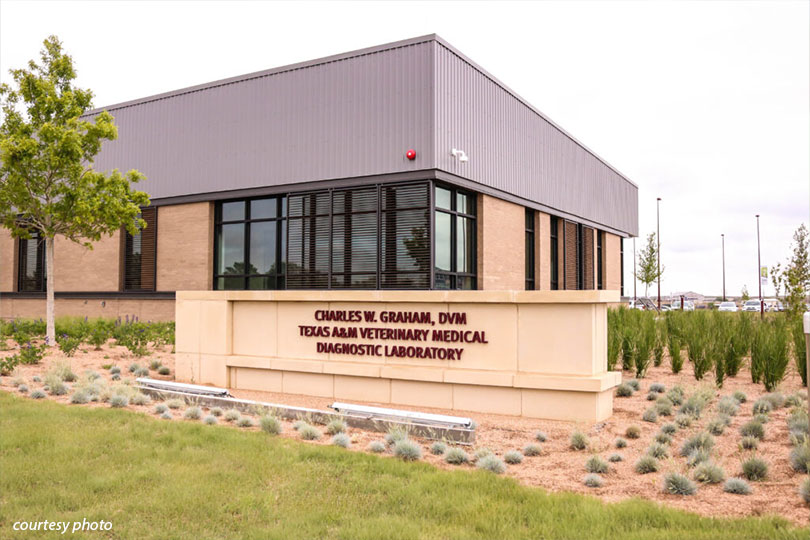By Jessica Domel
Multimedia Reporter
Texas laboratories are at the frontline of animal disease response and prevention, and they, along with the network of labs they’re a part of, will receive additional funding through the One Big Beautiful Bill Act.
The legislation, signed by the president July 4, provides $10 million per year for the National Animal Health Laboratory Network (NAHLN), which includes the Texas A&M Veterinary Medical Diagnostic Laboratory (TVMDL).
“Funding for the NAHLN, as well as funding for the National Animal Disease Preparedness and Response Program and National Animal Vaccine and Veterinary Countermeasures Bank, was substantially increased in the One Big Beautiful Bill,” U.S. Rep. Tracey Mann (R-KS), chairman of the House Agriculture Subcommittee on Livestock, Dairy and Poultry, said in a recent hearing. “The One Big Beautiful Bill included $233 million per year for the three-legged-stool with $10 million per year directed towards the NAHLN laboratories, which is on top of existing discretionary federal spending.”
NAHLN was established in 2002. At the time, it was comprised of 12 laboratories including TVMDL. Now, NAHLN has grown to include more than 60 state and university laboratories across the nation.
“This funding will increase diagnostic capabilities, improve research, assist in disease surveillance and strengthen our overall capacity as a nation to prevent, detect and mitigate foreign animal diseases,” Mann said.
Mann called the labs the first line of defense in protecting animal agriculture from foreign animal diseases like Highly Pathogenic Avian Influenza, New World screwworm and African swine fever.
“The laboratory network plays key roles in ensuring we have a safe and secure food supply chain for all Americans at their dinner table every evening,” said U.S. Rep. Jim Costa (D-CA), ranking member of the subcommittee. “This laboratory network is part of that safety response. It’s a foundation that allows us to respond rapidly to animal disease outbreaks simultaneously while keeping our food supply chain safe, and that’s a challenge.”
Costa said Congress must continue to support systems like NAHLN and corresponding research that allows the U.S. to create better diagnostic tools and preventative measures with the best available science.
Those tools and preventative measures are especially important in Texas, according to TVDML Assistant Agency Director Dr. Terry Hensley, who testified at the Congressional hearing July 15.
“Texas has features that increase its risk for the introduction of animal disease threats, including a 1,248-mile-long border with Mexico and multiple international land, sea and airports,” Hensley said. “Texas imports 1 million cattle annually from Mexico and 2.5 million cattle from other U.S. states.”
In addition to livestock, Hensley noted Texas has an abundance of feral, wild and farmed wildlife species and three major migratory flyways across the state.
“The interface between domestic and wildlife species poses a tremendous challenge for disease surveillance, detection and eradication,” Hensley said. “TVMDL’s work protects Texas $24 billion animal agriculture industries while enhancing the response preparedness of the NAHLN.”
The importance of both NAHLN and TVMDL was evident when a mysterious disease, now known to be HPAI, was found in dairy cattle in the Texas Panhandle in 2024.
“Dairy veterinarians sent samples to TVMDL, as well as our fellow NAHLN labs at Cornell University and Iowa State University,” Hensley said. “For several weeks, our laboratories ran every test that might provide an answer, but there were no definitive answers. When dairies reported large numbers of dead birds and cats, the possibility of a connection between Highly Pathogenic Avian Influenza and sick cattle was suggested.”
The NAHLN labs at Texas A&M, Cornell and Iowa State collaborated using shared samples from sick cattle and were able to confirm the presence of H5N1 (HPAI) in mammary tissue and milk.
Due to its location, Hensley said Texas may soon be ground zero for another incursion—New World screwworms.
“While we hope this pest can be contained south of the border, hope, as they say, is not a strategy,” Hensley said. “USDA’s National Animal Health Laboratory Network is, however, one vital strategy, serving as a cornerstone of the United States’ efforts to protect livestock and ensure the health and productivity of the animal agriculture sector.”
TVMDL is not solely funded through the federal budget. Hensley noted in the 88th Texas Legislature, which ended in May 2023, appropriations were approved for the new “Keeping Texas Prepared” initiative.
“This $96 million program brings together five state agencies that are tasked with disaster response and recovery: Texas A&M AgriLife Extension Service, Texas Division of Emergency Management, Texas A&M Engineering Extension Service, Texas A&M Forest Service and TVMDL,” Hensley wrote in his submitted testimony.
The agencies work together to discuss current and emerging disaster situations and threats.
TVMDL was appropriated $3.7 million per biennium specifically for the rapid detection of animal and human disease threats, but other NALHN labs do not necessarily receive funding from their state and additional federal funding may be needed, according to Hensley’s testimony.
NAHLN has been authorized $30 million since 2012 but has only been allocated $24.9 million from USDA’s Animal and Plant Health Inspection Service and National Institute of Food and Agriculture.
“These amounts are far below the $45 million needed for the NAHLN to fully support its mission,” Hensley wrote.
According to Hensley, in 2024, of the $24.9 million allocated to NAHLN, $7.89 million, or 32%, was used for fee-for-service testing for NAHLN program diseases like bovine spongiform encephalopathy, scrapie, African swine fever and HPAI and for foreign animal disease investigations.
More than $14 million, 58%, of the funding was used to support NAHLN member labs.
“While all NAHLN laboratories are grateful for the federal funding we receive, these amounts distributed across 64 laboratories do not go far,” Hensley wrote.
As a level 1 lab, TVMDL receives the highest level of NAHLN funding possible: $250,000 from the NIFA line Item, and $128,000 in infrastructure funding, for a total of $378,000, or about 1.5% of the TVMDL annual revenue budget.
“The money goes towards supporting portions of select staff salaries and purchasing certain equipment used for NAHLN testing,” Hensley wrote. “It is therefore easy to see how this federal funding leverages resources available at the state level to conduct testing that benefits the nation; however, it should be noted that all states are not resourced equally and many NAHLN laboratories are much more reliant on NAHLN funding to afford the equipment and personnel necessary to carry out the mission of the NAHLN.”
Hensley noted the $24.9 million has remained level for several years and has not increased despite the heavy burden placed on NAHLN labs by HPAI in poultry and dairy cattle.
“The NAHLN’s primary importance lies in its ability to facilitate early detection and rapid response to animal disease outbreaks,” Hensley wrote. “The network laboratories, strategically located across the United States, work collaboratively to conduct surveillance, diagnostic testing, and research. The rapid identification of pathogens enables swift action to contain and eradicate diseases, thus preventing their spread and minimizing their impact.”
He said ensuring NAHLN has sufficient funding will “aid in addressing our nation’s need for a safe, stable and nutritious food supply.”
TVMDL, which is a member of the Texas A&M University System, has four locations: College Station, Canyon, Center and Gonzales.
Each year, TVMDL processes more than 180,000 submissions and performs more than one million tests each year on samples submitted from across Texas, all 50 states and at least 20 countries.
“This network serves as our nation’s most vital early warning system for emerging and foreign animal diseases,” Hensley said.


Leave A Comment